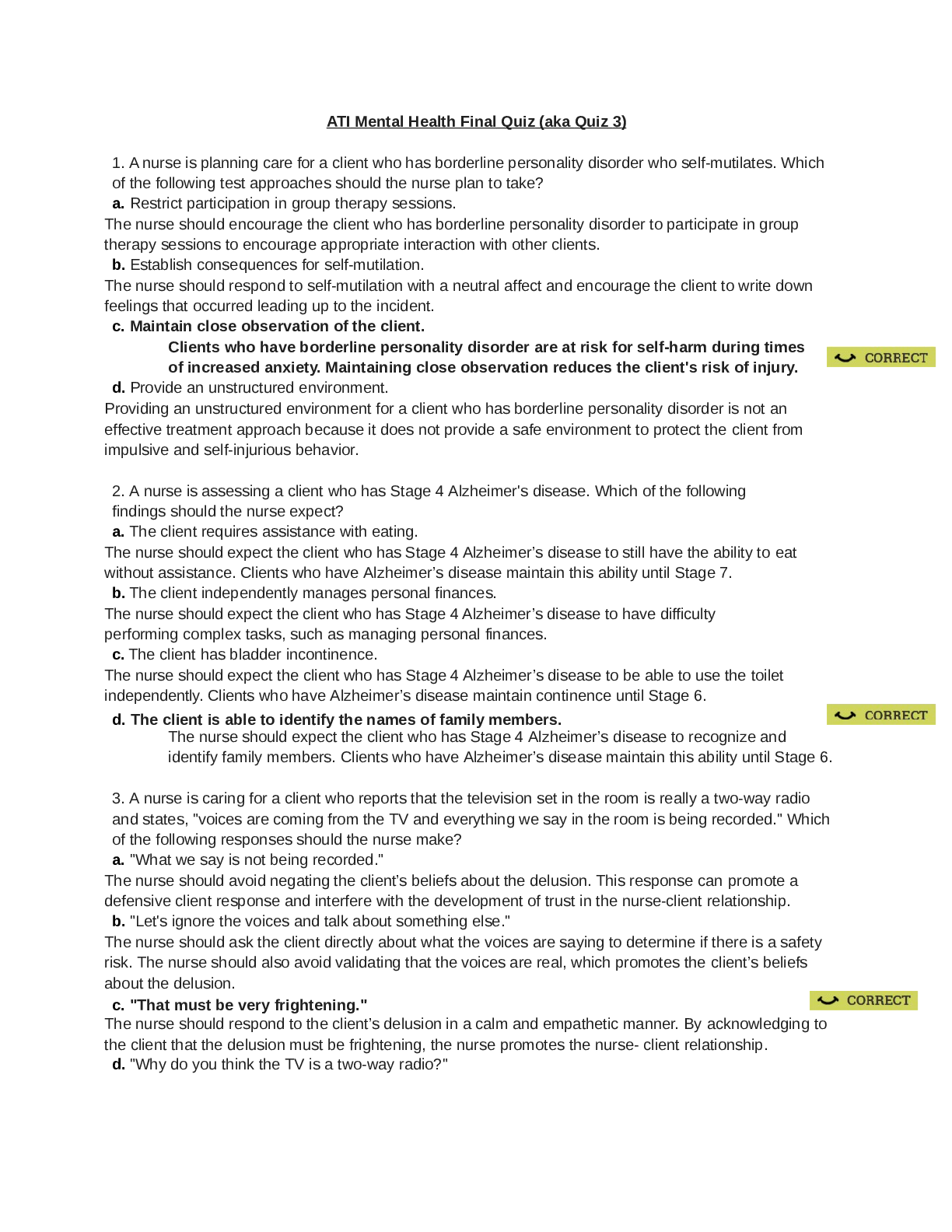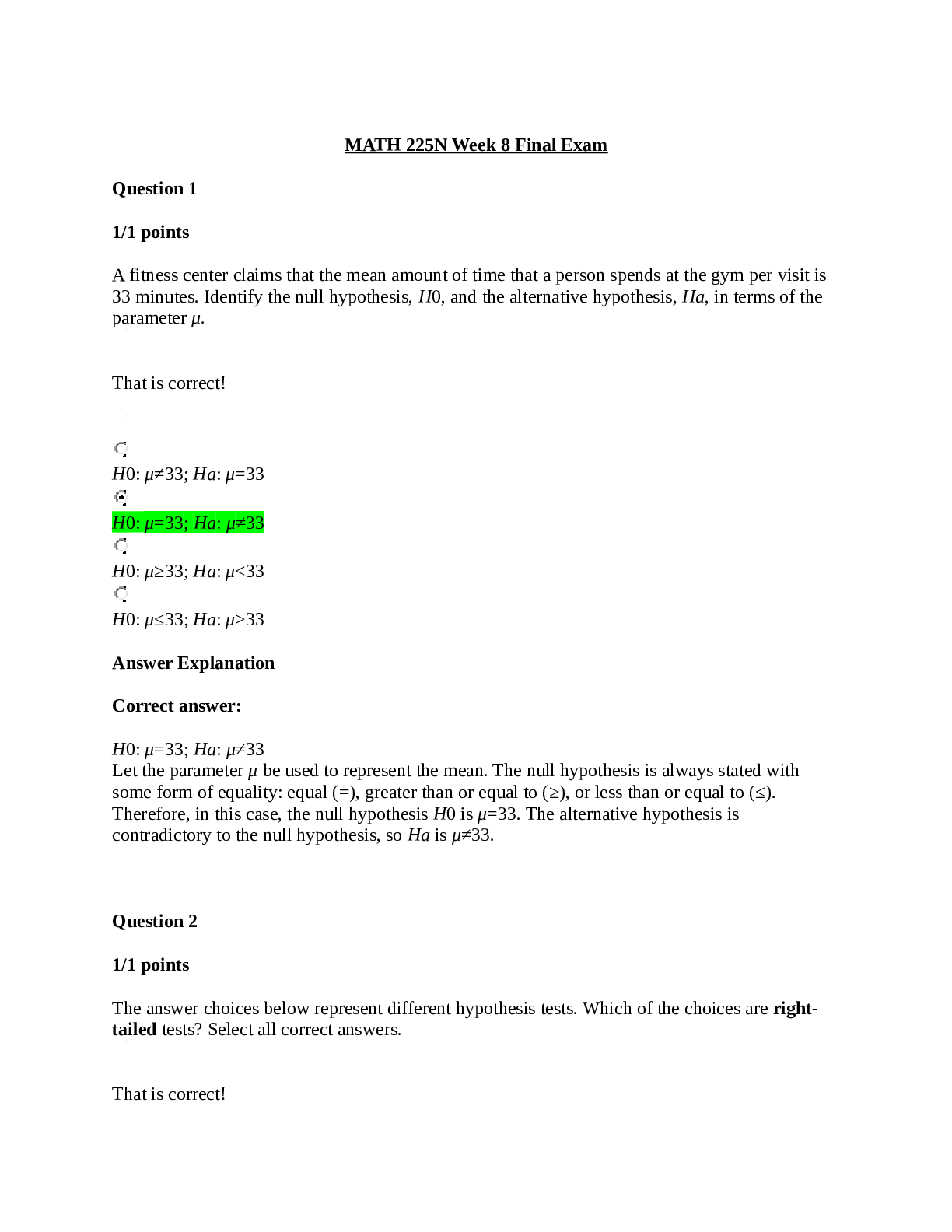*NURSING > EXAM > 2020 NCLEX-RN TEST PREP: MENTAL HEALTH (STUDY MODE) PRACTICE QUESTIONS WITH: ANSWERS & EXPLANATIONS (All)
2020 NCLEX-RN TEST PREP: MENTAL HEALTH (STUDY MODE) PRACTICE QUESTIONS WITH: ANSWERS & EXPLANATIONS
Document Content and Description Below
MENTAL HEALTH (TEST MODE) 1. A client has been diagnosed with a form of terminal cancer and has started receiving hospice care. The nurse notes that both the client and his family avoid talking ... about the diagnosis. All attempts at discussion result in changing the subject. The nurse recognizes that this family is exhibiting: a. Closed awareness b. Mutual pretense c. Open awareness d. Powerless assessment 2. A nurse is preparing to talk about body changes with a client who just had a bilateral mastectomy. Which of the following actions of the nurse is most appropriate during this discussion? a. Provide a room that offers minimal distractions b. Ask closed-ended questions to allow the client to think about her situation c. Write detailed notes during the conversation to track important information d. Ask personal questions about the client's background to determine how the procedure has affected her self-concept 3. A nurse is attempting to speak with a client about his personal feelings of self-esteem and self-concept. Which of the following questions is most appropriate for assessing a client's personal identity? a. What is your educational background?" b. Are your parents still living?" c. What do you like about your life right now?" d. Where do you see yourself in 10 years?" 4. A term that refers to a comprehensive set of thoughts or images of oneself is called: a. Global self b. Core self-concept c. Personal identity d. Ideal self 5. Which of the following interventions is most appropriate when supporting the psychosocial needs of a client who is experiencing negative side effects associated with chemotherapy? a. Read the client's discharge instructions well in advance of dismissal b. Provide medications to reduce nausea and vomiting c. Give simple instructions about self-care while in the hospital d. Determine the levels of support from significant others 6. Which of the following clients is at the highest risk of becoming a victim of intimate partner violence? a. A 36-year old woman who is recently divorced b. A 22-year old man who is unemployed but living with friends c. A 20-year old woman who grew up with a psychologically abusive father d. A 40-year old man diagnosed with schizophrenia 7. A nurse is assessing a client who is being seen for increased anxiety, restlessness, and insomnia. Which of the following interventions is the first priority of the nurse? a. Administer anti-anxiety medications as ordered by the physician b. Talk with the client about methods to improve rest and sleep c. Take the client to a private room and remain with him d. Review the client's medical history to determine if he has been treated for these issues before 8. Which of the following is an example of an opioid? a. Mescaline b. Diazepam c. Phenobarbital d. Methadone 9. A client comes into the emergency room and asks to see a doctor. He is anxious, visibly upset, and keeps looking behind him to the waiting room. When the nurse asks his chief complaint, he says, "My roommate is trying to kill me." Which of the following is the most appropriate initial response of the nurse? a. Just wait here and I will notify security." b. I'm going to speak with the physician about getting some medication that may help you." c. Why is your roommate trying to kill you?" d. Have you called the police to report this?" 10. A 17-year old Asian client is being seen for lower abdominal pain in the right quadrant. The client is accompanied by his parents. The nurse notes that the client's father does not make eye contact and shows little response when told that the client will need surgery. Which of the following is the most appropriate action of the nurse? a. Contact an interpreter to give the information again in the father's native language b. Continue to provide information about surgery to both the client and his parents c. Call social services to evaluate the parent's standard of care d. Contact the physician about postponing the surgery 11. Which of the following best describes Eye Movement Desensitization and Reprocessing (EMDR)? a. A client follows the nurse's finger with his eyes until he reaches a hypnotic state b. A client reads a story about a traumatic event and then visualizes the result c. A client focuses on a negative thought in his mind while moving his eyes back and forth d. None of the above 12. Which of the following is an example of neurofeedback used with a child diagnosed with reactive attachment disorder (RAD)? a. Parents or a nurse hold a child close during play until he becomes angry enough to unleash his rage b. Parents give their child a sticker when he behaves appropriately c. A child uses a sand tray to draw shapes and to release stress while talking with a nurse d. A child's brain waves are monitored through electrodes placed on the scalp 13. An increase in the neurotransmitter dopamine is associated with which of the following illnesses? a. Schizophrenia b. Depression c. Alzheimer's disease d. Anxiety 14. A nurse is using therapeutic techniques to help a client who is having difficulty applying for a job because of panic and anxiety. The nurse pretends to be the job supervisor while the client practices answering questions during an imaginary interview. This technique is an example of: a. Reinforcement b. Presenting reality c. Role playing d. Summarizing 15. Which of the following actions of the nurse is most appropriate when working with a client who is extremely angry? a. Place a light hand on the client's shoulder to imply understanding b. Maintain close proximity to convey trust c. Temporarily change the subject if the client's behavior is changing d. Close the door to the room to provide privacy 16. Which of the following is an advantage of working with psychiatric clients in a group setting? a. Clients assist each other through therapeutic interventions without a need for a nurse b. Clients can behave however they wish while knowing the group will not lead to long-term contact with others c. Clients can remain anonymous in sharing private information without the legal constraints of reporting illegal activities d. Clients learn from others when their behaviors are inappropriate in a safe and trusting environment 17. Which of the following interventions is most appropriate when working with the family of a client who is being treated for substance abuse? a. Advocate for the client before the family b. Provide referrals for community resources and support groups c. Take the side of the family before the client d. Both b and c 18. A term used to describe members of the same group based on physiological characteristics, such as skin color or body structure is known as: a. Ethnicity b. Culture c. Race d. Minority 19. Which of the following is an example of non-reversible dementia? a. Pick's disease b. Syphilis c. Encephalopathy d. Hyperthyroidism 20. Which of the following is a nursing intervention for a client who is having an acute panic attack? a. Encourage the client to sit down in a quiet environment b. Allow the client to direct the situation c. Try to focus the client on one aspect of care, such as regulating breathing patterns d. Speak in a commanding tone of voice to get the client's attention 21. A nurse is assisting a client who has been diagnosed with depression. Which of the following is an example of a short-term outcome as part of the nursing process for this client? a. Client will verbalize that depression symptoms have lifted b. Client will identify life stressors that may be contributing to depression c. Client's insomnia will be resolved as evidenced by 8 hours of sleep each night d. Client will identify a mental health counselor in the community with whom she can meet for ongoing therapy 22. Which of the following is an example of passive aggression? a. Clenched fists b. Yelling c. Jealousy d. Intimidation 23. A client is being treated for anxiety and desires to be free from anxious feelings and despair. According to Maslow's hierarchy of needs, which level does this client need to meet? a. Physiological b. Safety c. Belonging d. Self esteem 24. Which of the following is an age-related developmental task for a 68-year old client? a. Dealing with loss of friends b. Commitment to parenthood c. Setting career goals d. Solidification of sense of self 25. Which of the following examples indicates that the nurse is giving recognition as a form of therapeutic communication? a. You need to take your medicine now, Adam." b. Jill, your father is trying to make amends with you." c. The physician wants to meet with you and your husband, Amy." d. Linda, you brushed your hair this morning." 26. During her shift at the hospital, a nurse receives a stern reprimand from a physician over something which she had no control. The nurse does not respond. When she returns home that evening, she sees her children's toys all over the floor, gets mad, and begins to yell at them. Which form of defense mechanism is this nurse using? a. Symbolization b. Suppression c. Displacement d. Projection 27. A client is receiving treatment for delusional behavior. He believes that his neighbor is purposefully poisoning his water system in an attempt to make him sick. Which of the following responses of the nurse is most appropriate? a. Did you have the water tested to be sure?" b. Why do you feel like your neighbor is trying to poison you?" c. Let's just sit here and watch this television program." d. Don't be silly; your neighbor would do no such thing." 28. Which of the following people is at highest risk of suicide? a. An 80-year old man who lost his wife last year b. A 36-year old woman whose former neighbor committed suicide c. A 40-year old married businessman d. A 46-year old former alcoholic who has been sober for 12 years 29. Which of the following is a typical assessment finding of a 24 year old female with anorexia nervosa? a. Weight loss of more than 2% body fat b. Frequent binge-eating episodes following by induced vomiting c. A history of poor academic performance and mediocre achievements d. Lack of menstruation 30. A client is undergoing treatment for alcoholism. Twelve hours after his last drink, he develops tremors, increased heart rate, hallucinations, and seizures. Which stage of withdrawal is this client experiencing? a. Stage 1 b. Stage 2 c. Stage 3 d. Stage 4 31. Which of the following nursing interventions is essential when working with a client who has antisocial personality disorder? a. Monitor intake and output b. Set strict limits on behavior c. Provide diversion for the client d. Limit visits from family or friends 32. Which is a true statement regarding stress related disorders? a. Stress related disorders are only caused by stress b. Symptoms of stress related disorders would not exist if the client was not experiencing stress c. Stress related disorders are also called psychophysiologic disorders d. None of the above 33. Which of the following nursing outcomes is most appropriate during the crisis stage of caring for a victim of domestic violence? a. The client will verbalize community resources from which to seek shelter after discharge b. The client will write a plan to keep herself and her children safe c. The client will contact an attorney for help with pressing charges d. The client will be safe and receive treatment for injuries 34. Which of the following is a symptom associated with sensory overload? a. Disorientation b. Drowsiness c. Emotional lability d. Depression 35. A nurse is providing care for a client who has just died. Her son states, "She was the most wonderful mother. There was no one who was a better mother than she was. She was perfect." Which stage of grief is this son experiencing? a. Denial b. Anger c. Idealization d. Shock 36. Which of the following is a true statement about palliative care? a. The goal of palliative care is to provide end of life care for a client as he transitions toward death b. Palliative care provides comfort and support for those who may have a terminal illness c. Palliative care provides resources for funeral arrangements after death d. Palliative care is a support network for family and friends after the death of a loved one 37. According to the CDC, people in which of the following age groups are most likely to meet the criteria for major depression? a. 18-24 years b. 25-34 years c. 35-44 years d. 45-64 years 38. Your patient has been confused for years. Your patient can be best described as a patient with a chronic disorder. a. physical b. psychotic c. thinking d. palliative 39. At the end of your shift, Sophie T. starts crying when you walk into their room. Sophie is usually very cheerful. You speak to Sophie and she tells you that she is very sad because she has not seen her family in weeks. What should you do? a. Listen to Sophie with genuine concern. b. Tell Sophie that she should not cry. c. Immediately call the family so Sophie stops crying. d. You should leave because your shift is over. 40. The primary reason that people act out with disturbed behavior in a healthcare facility is because the person has a problem. a. social b. spousal c. thinking d. physical 41. The best way for a nurse, and a healthcare facility, to control the effects of poor and disruptive patient behavior is to . a. prevent it b. restrain the patient c. medicate the patient d. isolate the patient 42. Identify the "trigger" type with the correct "trigger" that can possibly lead to disturbed behavior. a. Emotional: room coldness b. Environmental: boredom c. Physical: pain d. Communication: silence 43. Jerry is a 55-year-old veteran who has been admitted after a motor vehicle accident with multiple injuries. His friend reported that he had been using synthetic marijuana prior to the accident, and that he also sees a psychiatrist at the VA hospital for an unknown diagnosis. He stated that Jerry sometimes gets “hyper” for no reason, starts “ranting” and becomes violent. Of the following, which general psychiatric disorder is characterized by a pattern of aggression or violence which includes irritability, agitation, and violent behavior during manic or psychotic episodes? a. Schizophrenia b. Post-traumatic stress disorder (PTSD) c. Bipolar disorder d. Delusional disorder 44. Of the following, which would NOT be helpful to include when developing Jerry's plan of care? a. Limiting choices b. Providing structure c. Encouraging patient input d. Ensuring availability of prn medications 45. Of the following, which often triggers an episode of violence or aggression by the patient with a psychiatric diagnosis that may involve violent behavior? a. Obtaining a history b. Asking for input into care c. Enforcing rules d. Taking a walk 46. Which of the following medications would NOT be an appropriate prn medication for use during an episode of aggression or violence for the patient with a psychiatric diagnosis? a. Olanzapine b. Meperidine c. Ziprasidone d. Haloperidol 47. Which of the following is an appropriate tension-reduction intervention for the patient who may be escalating toward aggressive behavior? a. Asking to speak to someone b. Asking to be alone c. Listening to music d. All of the above 48. Causes which contribute to delirium are often remembered as an acronym of the same name. What cause does the E in DELIRIUM represent? a. EEG b. EKG c. Electrolytes d. Echocardiogram 49. Which of the following mental health situations is considered a psychiatric emergency? a. Seasonal Affective Disorder (SAD) b. Depression with melancholic features c. Major depressive episode with psychotic features d. Bipolar depression [Show More]
Last updated: 1 year ago
Preview 1 out of 28 pages
Instant download
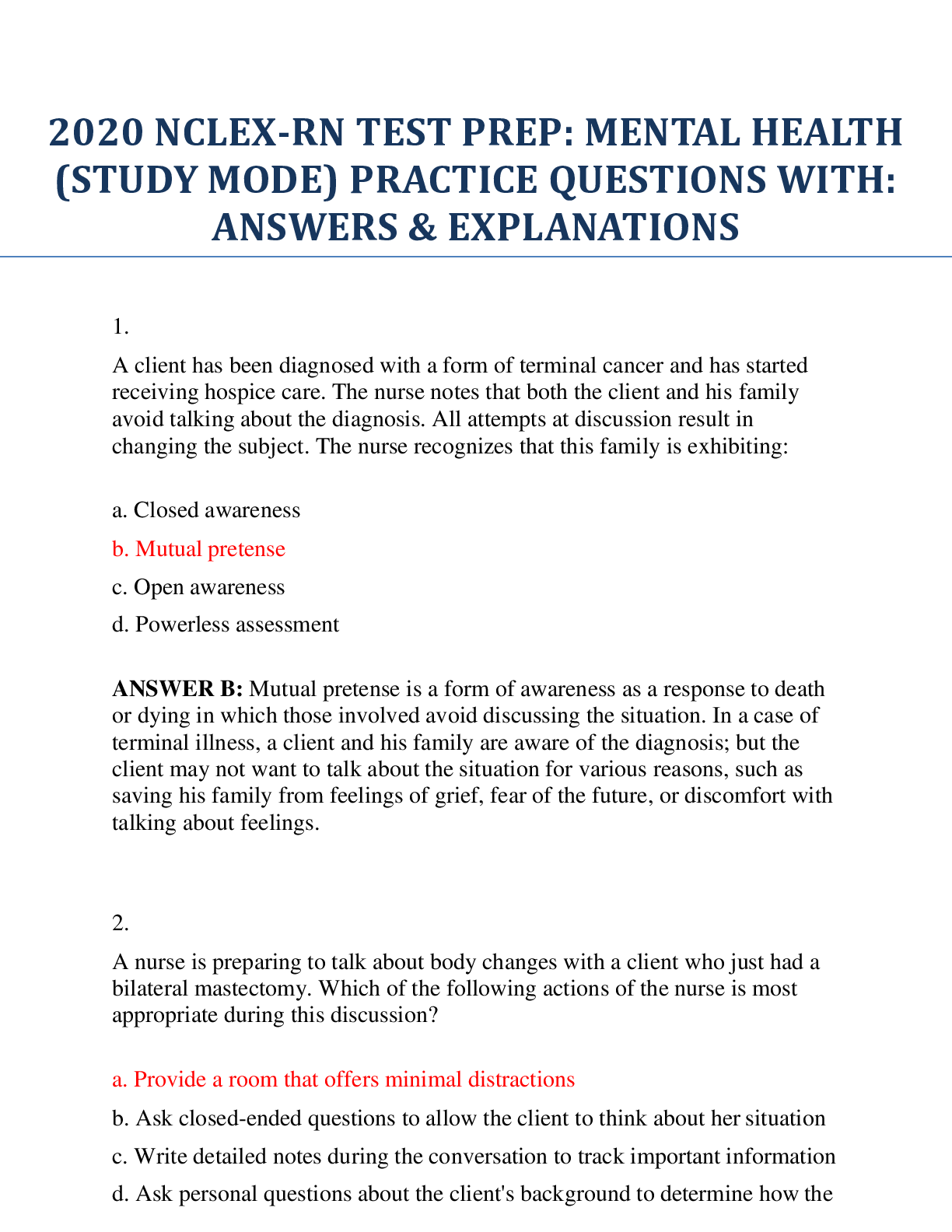
Buy this document to get the full access instantly
Instant Download Access after purchase
Add to cartInstant download
Reviews( 0 )
Document information
Connected school, study & course
About the document
Uploaded On
Jun 14, 2020
Number of pages
28
Written in
Additional information
This document has been written for:
Uploaded
Jun 14, 2020
Downloads
0
Views
59



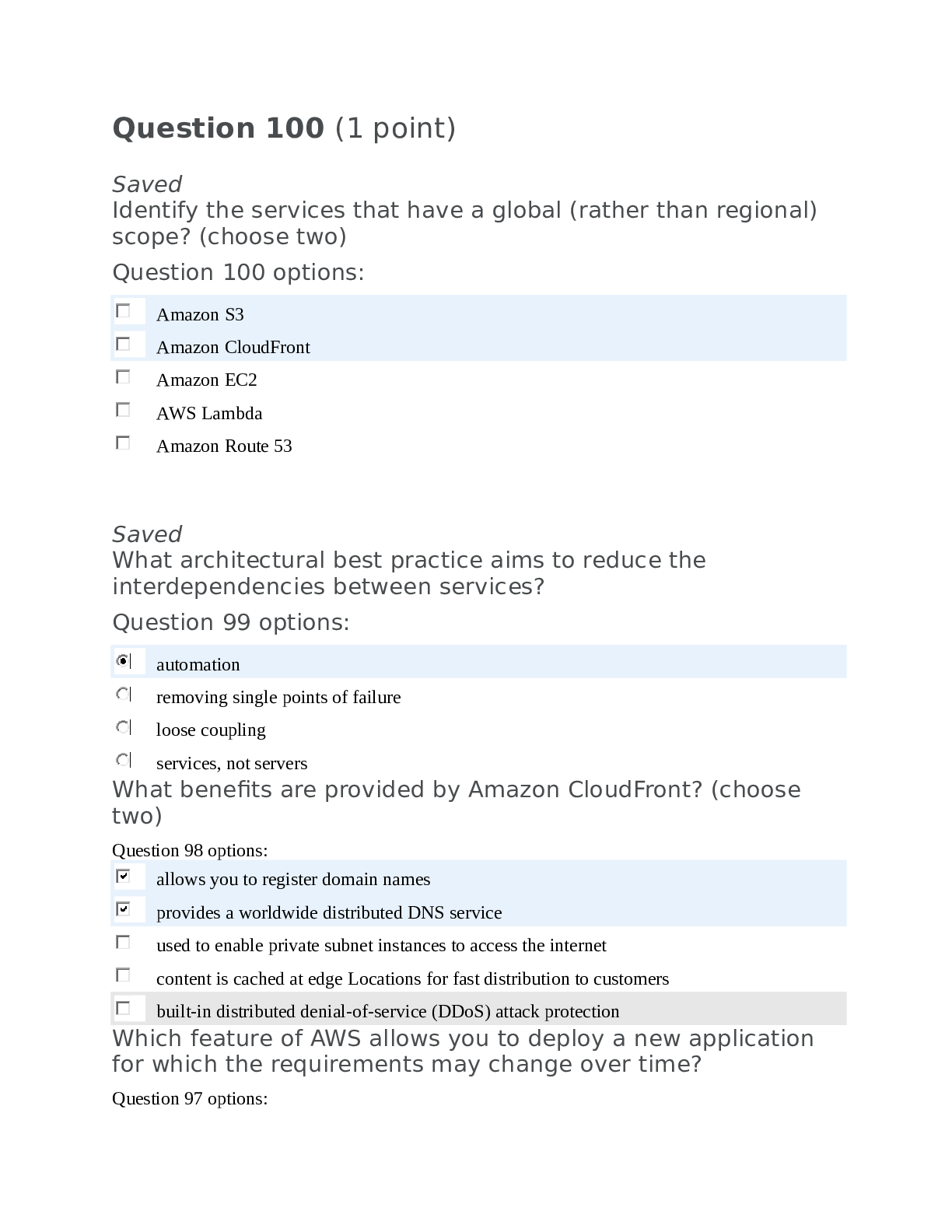

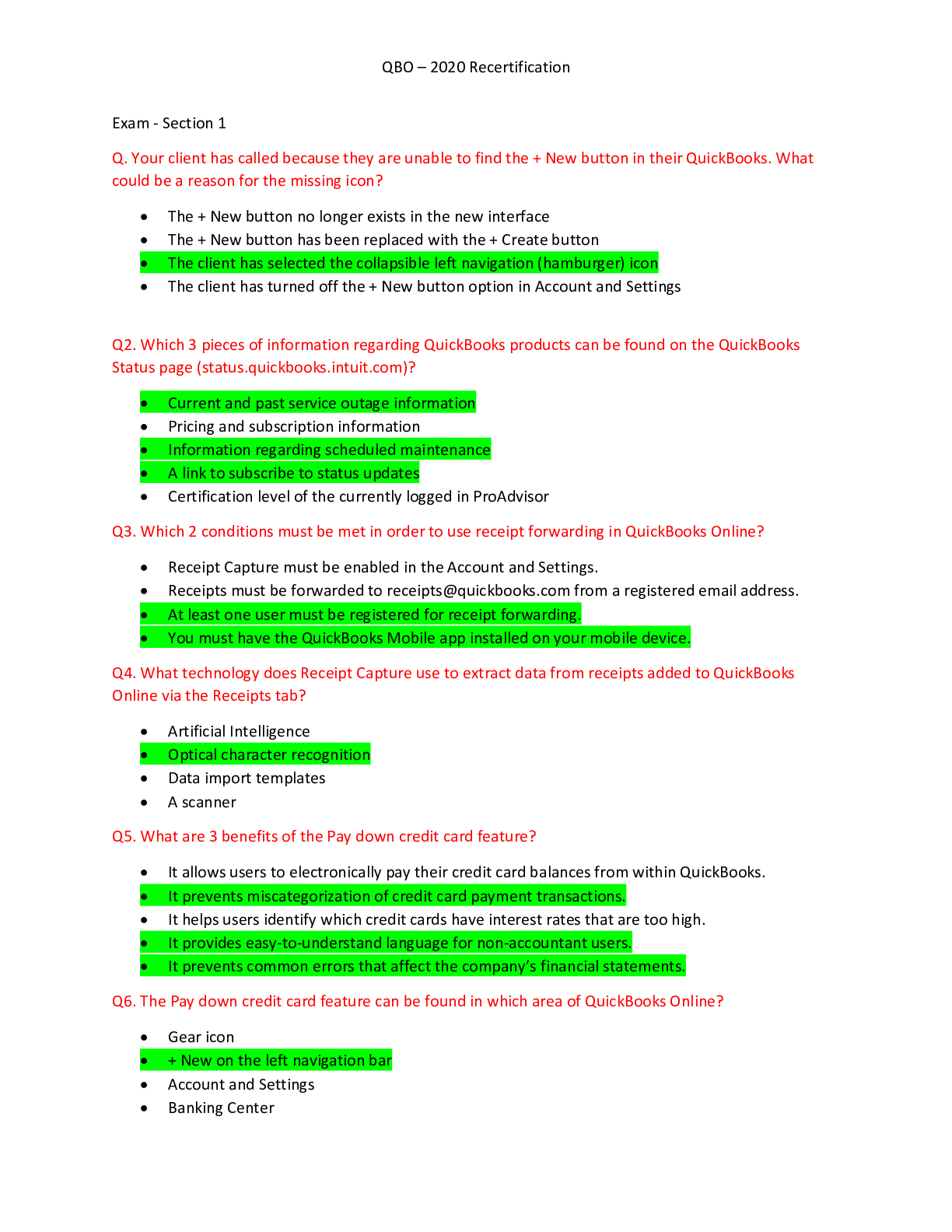
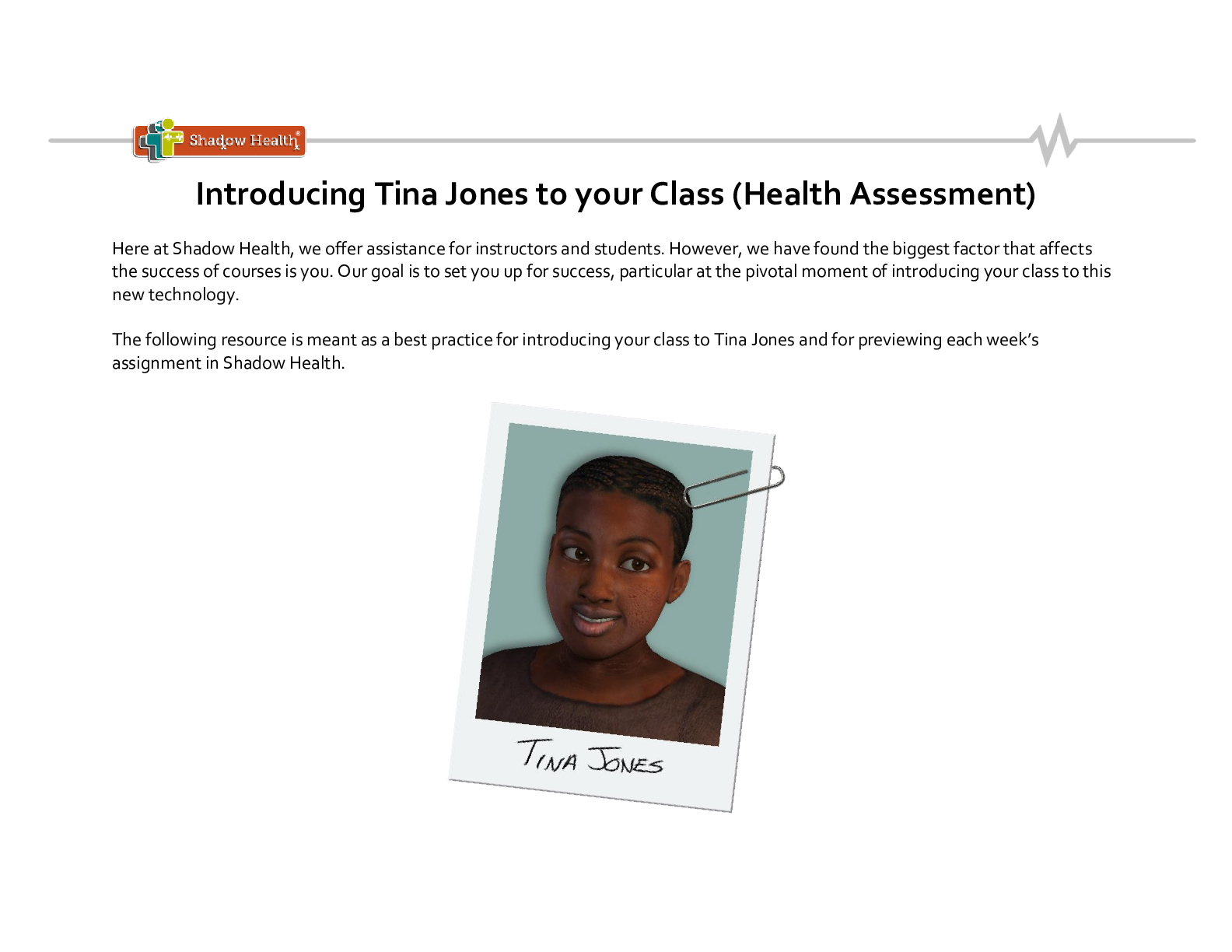


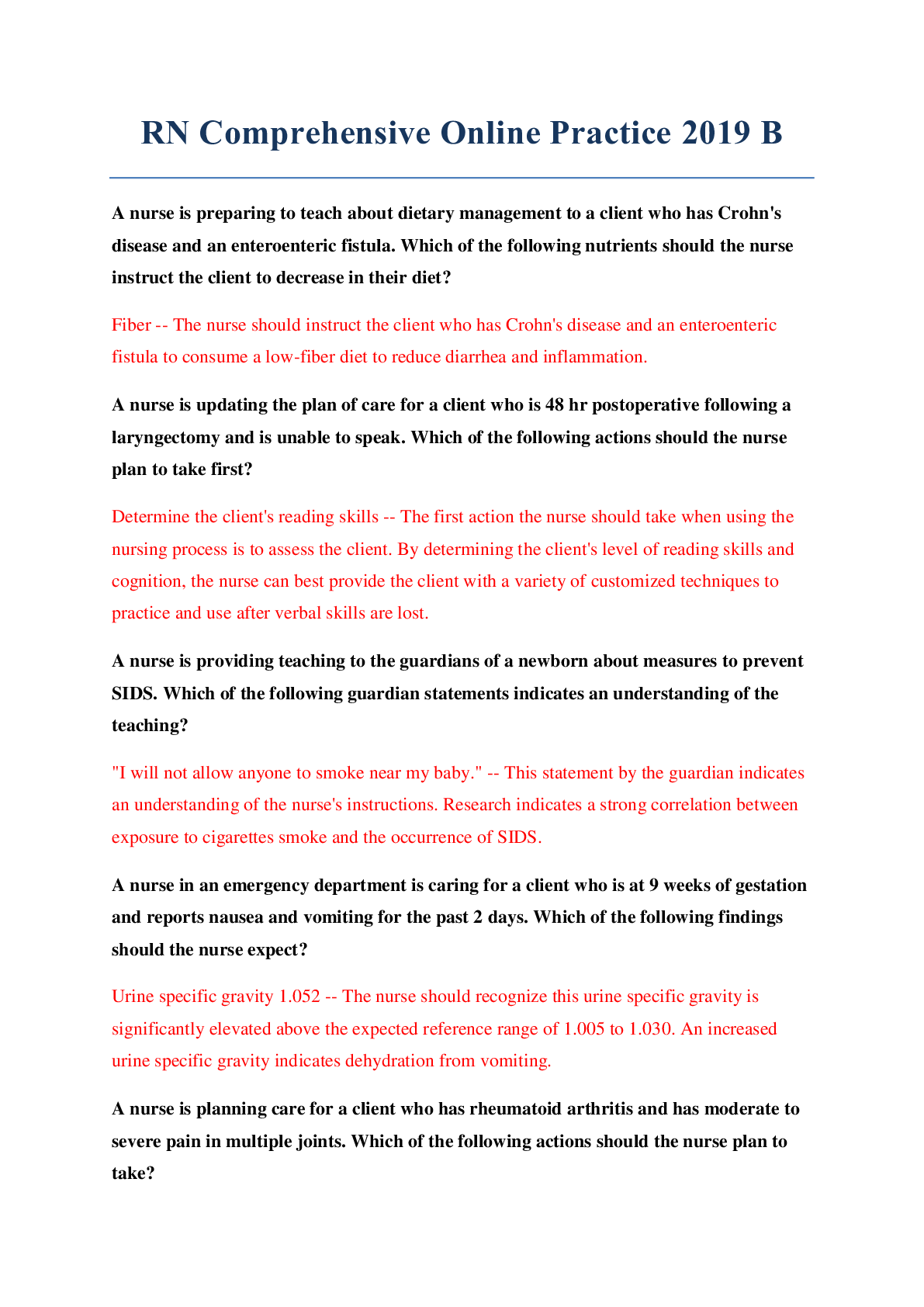




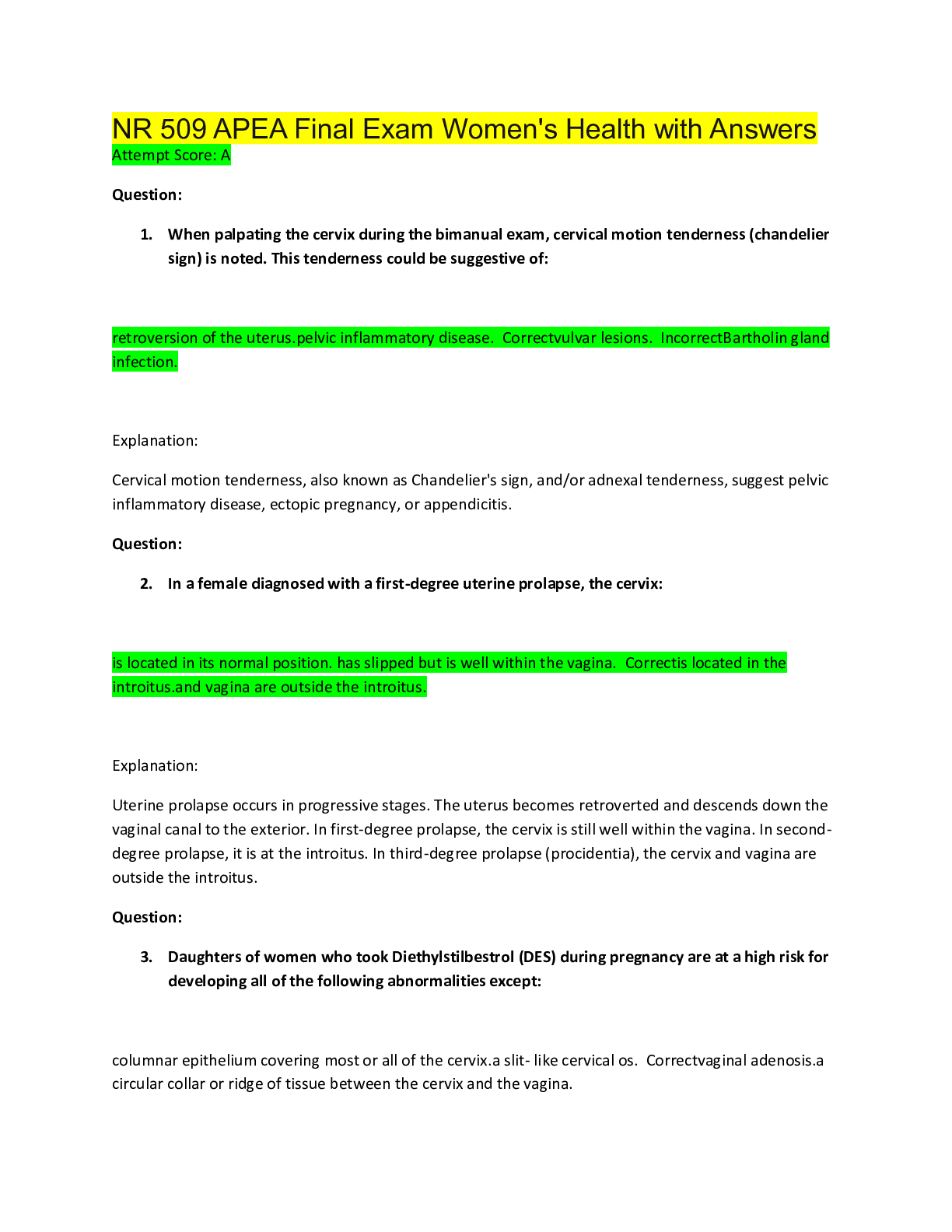
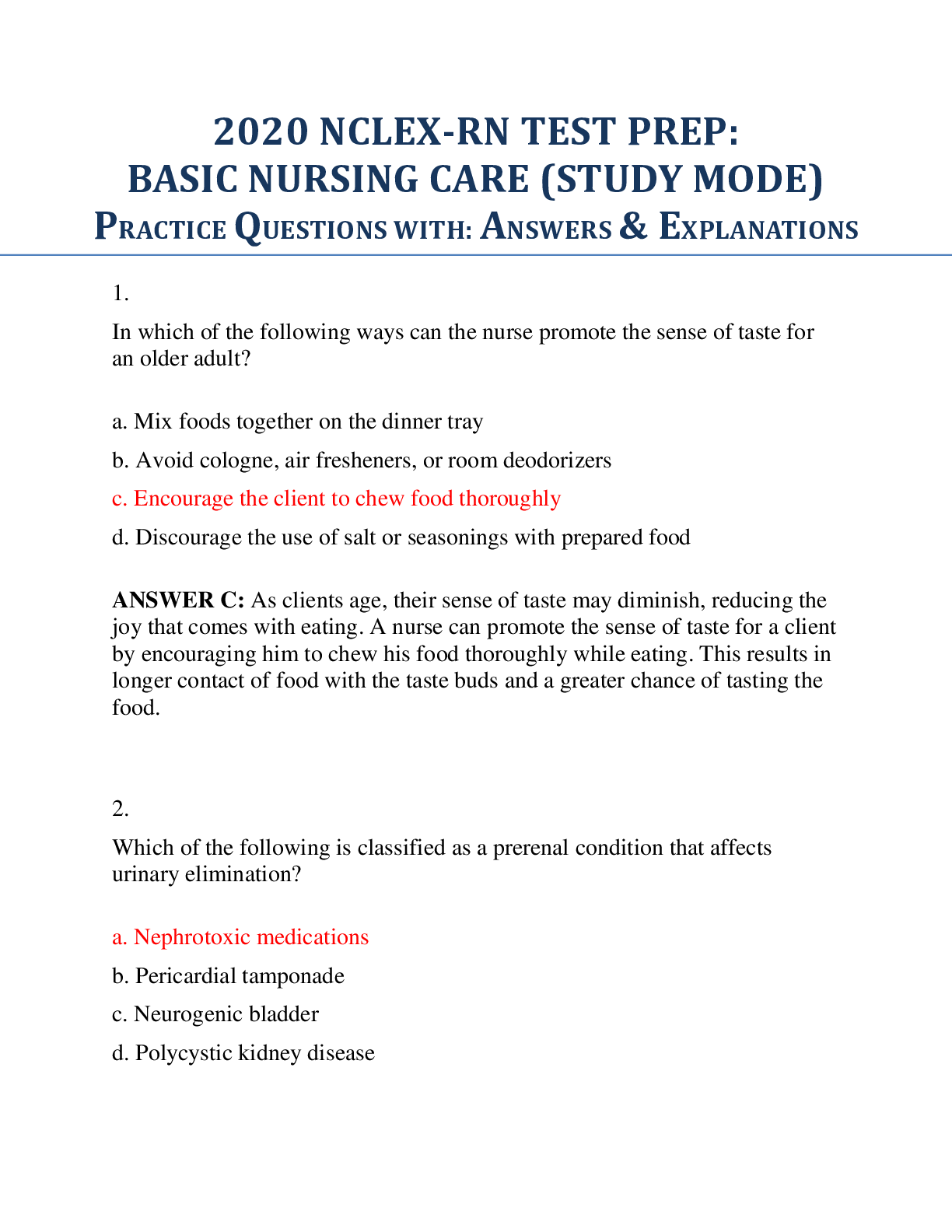
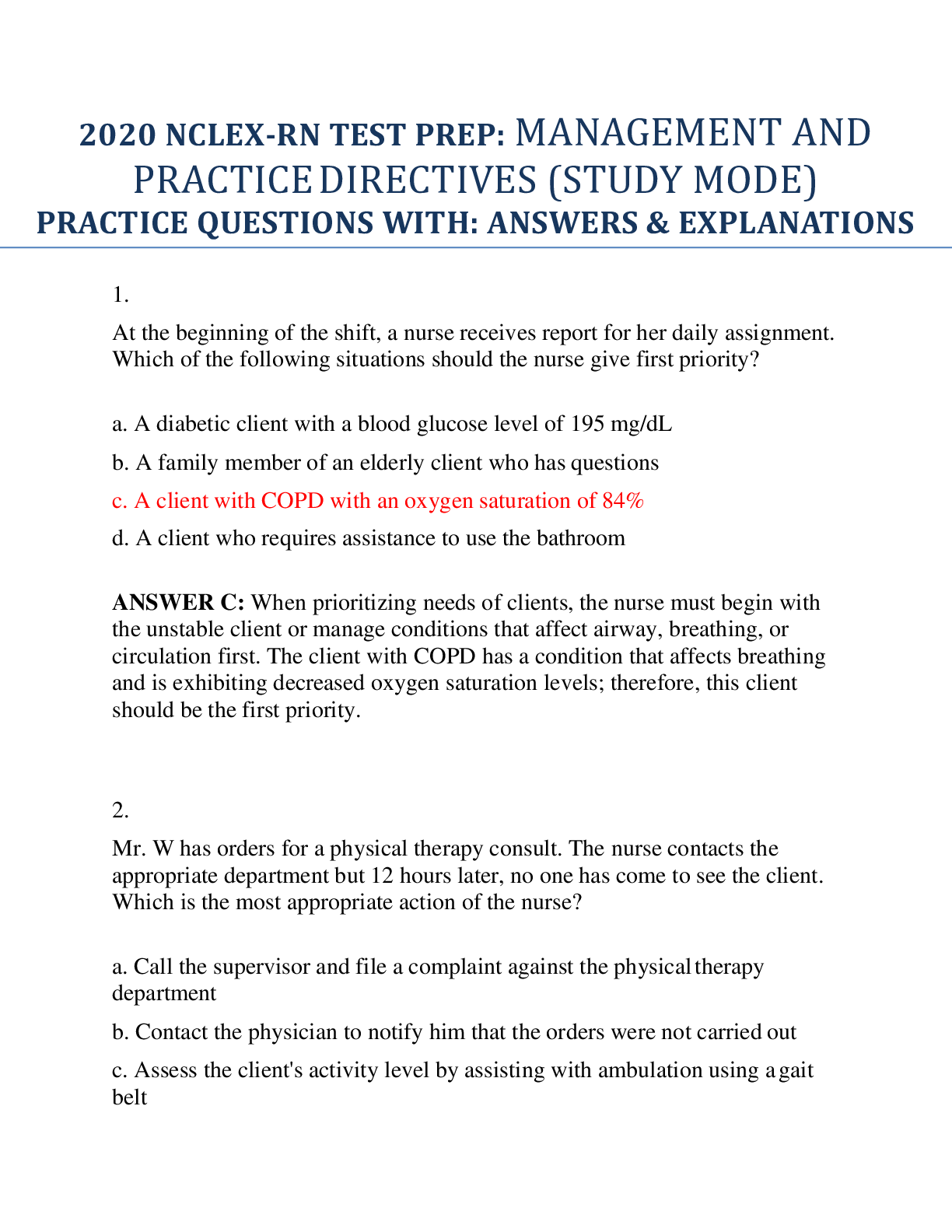
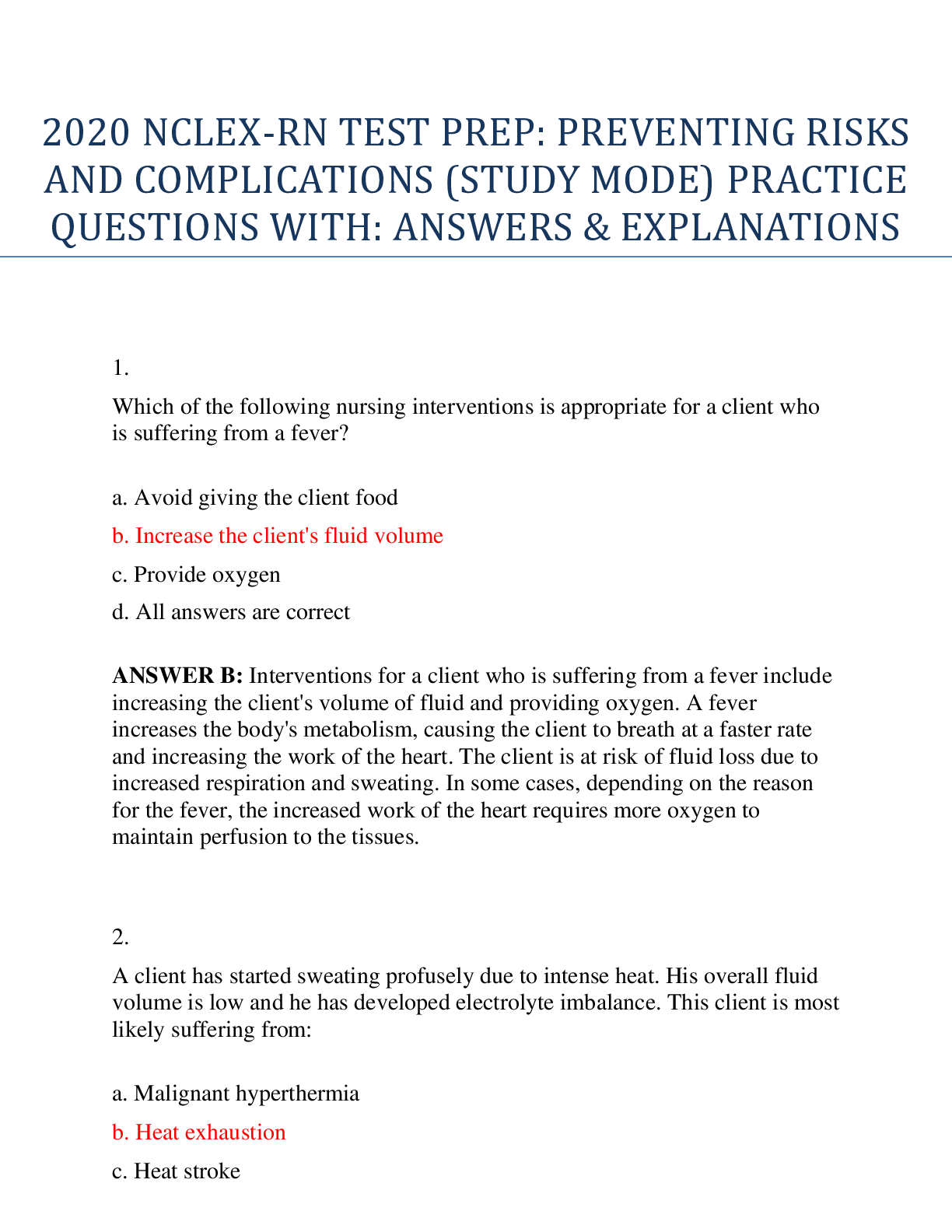


_Answers & Explanations_2020 – Chamberlain College of Nursing.png)
